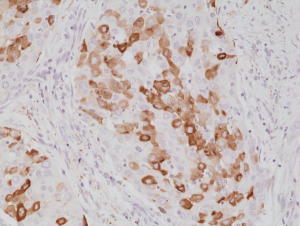anti-Surfactant protein A (human) Rabbit Monoclonal (RM334)
| Code | Size | Price |
|---|
| REV-31-1221-00-R100 | 100 ul | £455.00 |
Quantity:
Prices exclude any Taxes / VAT
Overview
Antibody Isotype: Rabbit IgG
Antibody Clonality: Recombinant Antibody
Antibody Clone: RM334
Regulatory Status: RUO
Target Species: Human
Applications:
- Immunohistochemistry (IHC)
- Western Blot (WB)
Shipping:
Blue Ice
Storage:
+4°C
Images
Documents
Further Information
Alternate Names/Synonyms:
SP-A; PSPA; Alveolar Proteinosis Protein
Concentration:
N/A
EClass:
32160000
Form (Short):
liquid
Formulation:
Liquid. 50% Glycerol/PBS with 1% BSA and 0.09% sodium azide.
Handling Advice:
Avoid freeze/thaw cycles.
Immunogen:
A peptide corresponding to the C-terminus of human Surfactant protein A (SP-A).
Long Description:
Recombinant Antibody. This antibody reacts to human Surfactant protein A (SP-A). Applications: WB, IHC. Source: Rabbit. Liquid. 50% Glycerol/PBS with 1% BSA and 0.09% sodium azide. Surfactant protein A (SP-A) is an abundant, phospholipid-associated protein in pulmonary surfactant. SP-A is expressed primarily by type II and bronchiolar cells in the respiratory epithelium. In the alveolus, SP-A forms large oligomers and is closely associated with tubular myelin, the major extracellular form of surfactant. SP-A contains a 10-kDa collagen-like amino-terminal domain and a globular carboxyl-terminal domain with structural homology to SP-D, mannose binding protein, Clq, and other members of the collectin family of mammalian lectins. Together with SP-D, SP-A plays an important role in pulmonary innate immunity by recognizing canonical patterns on microbial surfaces. These host defense proteins protect the lung from infection by recognizing the carbohydrate and/or lipid component on pathogens, including bacteria, virus and fungi, and by helping to initiate various clearance mechanisms. It was shown that SP-A activates alveolar macrophage metabolism, and enhances the uptake of bacterial pathogens by both macrophages and monocytes. In addition, SP-A has been shown to serve as a hormone in parturition through its ability to modulate proinflammatory cytokine production, as well as in several other functions which include enhancing phospholipid uptake, inhibiting surfactant secretion by isolated type II epithelial cells, contributing to tubular myelin formation, enhancing surfactant spreading, stabilizing phospholipid mixtures and conferring resistance to protein mediated inactivation of surfactant. SP-A polymorphisms play a role in respiratory distress syndrome, allergic bronchopulmonary aspergillosis and idiopathic pulmonary fibrosis. The levels of SP-A are decreased in the lungs of patients with cystic fibrosis, respiratory distress syndrome and further chronic lung diseases. The interaction of SP-A with type II cells is a receptor-mediated process.
NCBI, Uniprot Number:
Q8IWL1
Package Type:
Vial
Product Description:
Surfactant protein A (SP-A) is an abundant, phospholipid-associated protein in pulmonary surfactant. SP-A is expressed primarily by type II and bronchiolar cells in the respiratory epithelium. In the alveolus, SP-A forms large oligomers and is closely associated with tubular myelin, the major extracellular form of surfactant. SP-A contains a 10-kDa collagen-like amino-terminal domain and a globular carboxyl-terminal domain with structural homology to SP-D, mannose binding protein, Clq, and other members of the collectin family of mammalian lectins. Together with SP-D, SP-A plays an important role in pulmonary innate immunity by recognizing canonical patterns on microbial surfaces. These host defense proteins protect the lung from infection by recognizing the carbohydrate and/or lipid component on pathogens, including bacteria, virus and fungi, and by helping to initiate various clearance mechanisms. It was shown that SP-A activates alveolar macrophage metabolism, and enhances the uptake of bacterial pathogens by both macrophages and monocytes. In addition, SP-A has been shown to serve as a hormone in parturition through its ability to modulate proinflammatory cytokine production, as well as in several other functions which include enhancing phospholipid uptake, inhibiting surfactant secretion by isolated type II epithelial cells, contributing to tubular myelin formation, enhancing surfactant spreading, stabilizing phospholipid mixtures and conferring resistance to protein mediated inactivation of surfactant. SP-A polymorphisms play a role in respiratory distress syndrome, allergic bronchopulmonary aspergillosis and idiopathic pulmonary fibrosis. The levels of SP-A are decreased in the lungs of patients with cystic fibrosis, respiratory distress syndrome and further chronic lung diseases. The interaction of SP-A with type II cells is a receptor-mediated process.
Purity:
Protein A purified.
Source / Host:
Rabbit
Specificity:
This antibody reacts to human Surfactant protein A (SP-A).
Transportation:
Non-hazardous
UNSPSC Category:
Primary Antibodies
UNSPSC Number:
12352203
Use & Stability:
Stable for at least 1 year after receipt when stored at -20°C.



